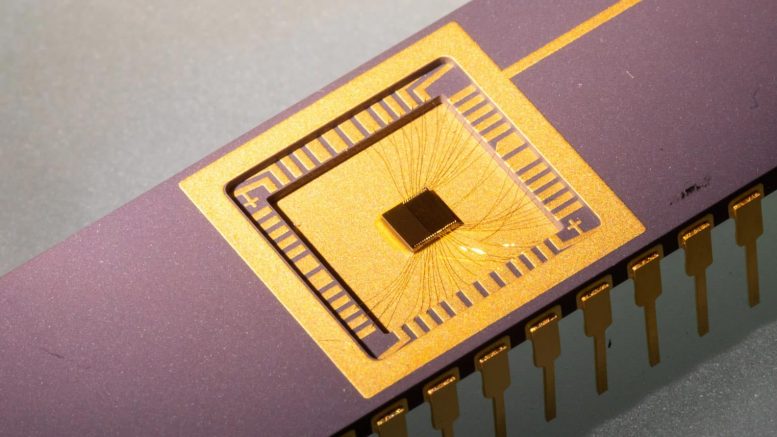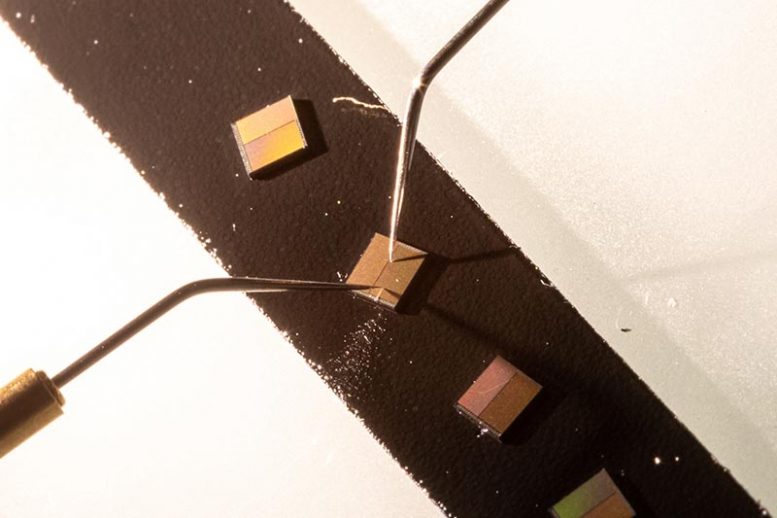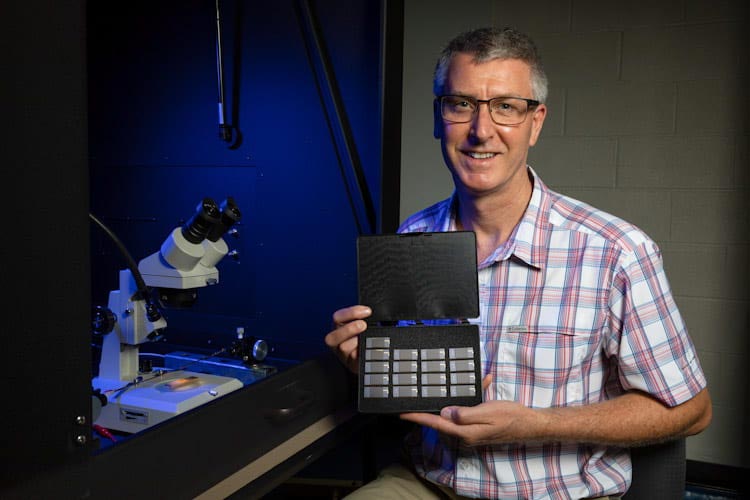
Posted on 10/02/2020 7:09:57 AM PDT by Red Badger

Researchers build circuit that harnessed the atomic motion of graphene to generate an electrical current that could lead to a chip to replace batteries.
============================================================================
A team of University of Arkansas physicists has successfully developed a circuit capable of capturing graphene’s thermal motion and converting it into an electrical current.
“An energy-harvesting circuit based on graphene could be incorporated into a chip to provide clean, limitless, low-voltage power for small devices or sensors,” said Paul Thibado, professor of physics and lead researcher in the discovery.
The findings, published in the journal Physical Review E, are proof of a theory the physicists developed at the U of A three years ago that freestanding graphene — a single layer of carbon atoms — ripples and buckles in a way that holds promise for energy harvesting.
The idea of harvesting energy from graphene is controversial because it refutes physicist Richard Feynman’s well-known assertion that the thermal motion of atoms, known as Brownian motion, cannot do work. Thibado’s team found that at room temperature the thermal motion of graphene does in fact induce an alternating current (AC) in a circuit, an achievement thought to be impossible.
===========================================================================

Graphene chip testing — A sample energy-harvesting chip under development. Credit: University of Arkansas
==============================================================================
In the 1950s, physicist Léon Brillouin published a landmark paper refuting the idea that adding a single diode, a one-way electrical gate, to a circuit is the solution to harvesting energy from Brownian motion. Knowing this, Thibado’s group built their circuit with two diodes for converting AC into a direct current (DC). With the diodes in opposition allowing the current to flow both ways, they provide separate paths through the circuit, producing a pulsing DC current that performs work on a load resistor.
Additionally, they discovered that their design increased the amount of power delivered. “We also found that the on-off, switch-like behavior of the diodes actually amplifies the power delivered, rather than reducing it, as previously thought,” said Thibado. “The rate of change in resistance provided by the diodes adds an extra factor to the power.” The team used a relatively new field of physics to prove the diodes increased the circuit’s power. “In proving this power enhancement, we drew from the emergent field of stochastic thermodynamics and extended the nearly century-old, celebrated theory of Nyquist,” said coauthor Pradeep Kumar, associate professor of physics and coauthor.
According to Kumar, the graphene and circuit share a symbiotic relationship. Though the thermal environment is performing work on the load resistor, the graphene and circuit are at the same temperature and heat does not flow between the two.
VIDEO OF PROCESS AT LINK:
Thibado’s energy-harvesting circuit uses the atomic motion of graphene to generate an electrical current that can perform work. Credit: Illustration by Ashley Acord.
=========================================================================
That’s an important distinction, said Thibado, because a temperature difference between the graphene and circuit, in a circuit producing power, would contradict the second law of thermodynamics. “This means that the second law of thermodynamics is not violated, nor is there any need to argue that ‘Maxwell’s Demon’ is separating hot and cold electrons,” Thibado said.
The team also discovered that the relatively slow motion of graphene induces current in the circuit at low frequencies, which is important from a technological perspective because electronics function more efficiently at lower frequencies.

Paul Thibado, professor of physics, holds prototype energy-harvesting chips. Credit: Russell Cothren, University of Arkansas
=============================================================================
“People may think that current flowing in a resistor causes it to heat up, but the Brownian current does not. In fact, if no current was flowing, the resistor would cool down,” Thibado explained. “What we did was reroute the current in the circuit and transform it into something useful.”
The team’s next objective is to determine if the DC current can be stored in a capacitor for later use, a goal that requires miniaturizing the circuit and patterning it on a silicon wafer, or chip. If millions of these tiny circuits could be built on a 1-millimeter by 1-millimeter chip, they could serve as a low-power battery replacement.
Reference: 2 October 2020, Physical Review E. DOI: 10.1103/PhysRevE.102.042101
The University of Arkansas holds several patents pending in the U.S. and international markets on the technology and has licensed it for commercial applications through the university’s Technology Ventures division. Researchers Surendra Singh, University Professor of physics; ; Hugh Churchill, associate professor of physics; and Jeff Dix, assistant professor of engineering, contributed to the work, which was funded by the Chancellor’s Commercialization Fund supported by the Walton Family Charitable Support Foundation.
“Everything is impossible until someone does it.” .... Robert Heinlein...................
I know there is outside energy involved (ambient heat) but this sounds too much like a perpetual motion machine.
“Perpetual Motion” is impossible.
“ALMOST Perpetual Motion” is possible.....................
Thibado’s team found that at room temperature the thermal motion of graphene does in fact induce an alternating current (AC) in a circuit, an achievement thought to be impossible.
—
This is the atomic-level version of harnessing vacuum energy. Extremely cool if it’s really working.
Its also a question of scale. Like solar, wind, etc… they would find that you very quickly reach diminishing returns. They mentioned “low voltage.” Perhaps they can generate enough energy to keep a very sophisticated computer chip “on” at some greatly reduced state.
But what about moving a 3000 lb car down the road at 60 mph?
The left DOES NOT WANT 'clean, limitless power'!!!
They want you shut down and subject to their control.
Zero Population Growth etc.
https://www.amazon.com/Feynman-Lectures-Physics-boxed-set/dp/0465023827
“Don’t ever become a pessimist... a pessimist is correct oftener than an optimist, but an optimist has more fun, and neither can stop the march of events.”
RAH
What is the Frequency?
I didn’t see the usual
“Research continues, only a few billion more in funding is needed for a ‘commercial’ product.
I’m still waiting to get my hands on a fuel cell powered by NatGas to power/heat me home.
Huh? These units are all over Britain. I’d love to cut the cord...
Photosynthesis seems pretty crazy, too.
Clean, Limitless Power ?
Democrats will be against as the price of energy would be lower and they cannot turn off the power to your home as you will have your own generator powered by the graphene.
I am thinking this could open up a whole new area of bio-medical power supply. Interesting development.
At first I too thought of “Perpetual Motion” but then realized it was more a “Sterling Engine”/heat differential at the molecular level moving electrons rather than a mechanical work. Definitely on the AMAZING level, if true I’d see a Nobel Prize for Physics potential.
Sincerely hope it is not a Pons&Fleischmann “Cold Fusion” (1989) disappointment. NOTE: I say ‘disappointment’ as I think that they were sincere in their research, at least at the beginning. MHO.
There is no such thing as free lunch.
If this is true, it is the last time you will ever read about it.
The universe is awash in energy called zero point energy or dark energy or whatever that will soon be harvested.
New technology, when presented to the people seems like a magic.
It’s not ‘free’..................
Disclaimer: Opinions posted on Free Republic are those of the individual posters and do not necessarily represent the opinion of Free Republic or its management. All materials posted herein are protected by copyright law and the exemption for fair use of copyrighted works.